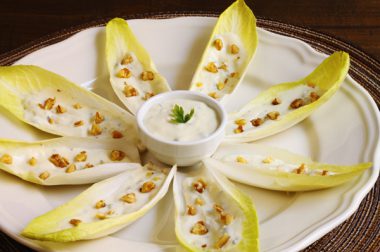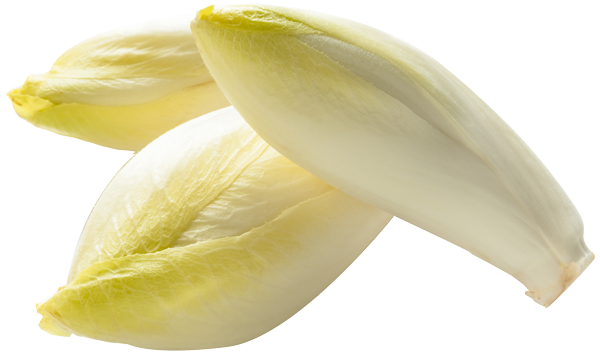Recipes we love
See all recipesChicory with ham
A typical French cuisine dish that subtlety triggers an explosion of flavours on the palate No short...
Chicory and beetroot salad
A fresh, tasty and light salad, ideal for summer meals to share with friends or family. A starter fu...
Pan-fried chicory
It doesn’t take much to make a delicious vegetable dish ! One shallot and a bit of oil are all you n...
HEALTH
BENEFITS
Bitter but light!
Endives are a light and refreshing vegetable, made up of nearly 95% water. They are low in calories, containing only 20 kcal/100 g, and are rich in fiber.
NUTRITIONAL
COMPOSITION
WHEN IS THE RIGHT
TIME TO EAT THEM?
Winter
Endives are considered to be a winter vegetable. They are in season from October to April. However, they are becoming less tied to season and are increasingly sold in spring and summer.
VEGETABLE PATCH
OR URBAN BALCONY?
Endives grow well in well-drained, cool, light soil that is rich in humus, with a neutral pH (pH = 7).
To learn everything you need to know about growing endives, read the page on growing advice.
CHOOSING
AND STORING ENDIVES
Choose your endives well :
- Endive leaves should be tightly closed, and the ends should beyellowin color.
- Green ends signal a lack of freshness and a highly bitter taste.
Store your endives properly :
- Always keep endives away from light! Otherwise their leaves will begin to turn green.
- Store endives in the refrigerator:They keep up to 4-5 days in the vegetable drawer.
ANTI-WASTE TIPS
Good news for the planet: the whole of the endive can be consumed, so you don’t have to waste any of it! Do you prefer to use only the heart of an endive? Then keep the rest to make a soup, for example.
WHAT IS
THE ENVIRONMENTAL IMPACT?
The Product Environmental Footprint (PET) tells us more! This is a score, calculated by Agribalyse*, which takes into account all of the stages of a vegetable’s life cycle: how it is grown, the impact of transport and processing, and so on. The lower the score, the lower the environmental impact.
- Endive, raw: 0.12
- Beefsteak, raw: 2.70
<h6*Data taken from the Agribalyse database, which records the environmental score of food items. This unique score is an average of 16 indicators, calculated according to the European PEF methodology. It does not correspond to an environmental label or “eco-score”.
CO2 equivalent: For 100 g of raw endive: 0.093 kg of CO2e, which is the same as 3.3 g of raw beefsteak.
TIPS
AND TRICKS
How to prepare endives
You can eat the entire endive, making it a nearly waste-free vegetable! What’s more, they are incredibly easy to prepare.
Remove any damaged leaves. Quickly rinse the others without soaking them (which makes them even more bitter), then dry them.
Endives can be eaten both raw and cooked. All cooking methods work with endives.
Cooking times:
- 10 min: steamed
- 20 min: in boiling water
- 5 min: in the microwave
- 15 to 25 min: sautéed
- 30 min: in the oven
Tip for reducing the bitterness of endives during cooking: Remove the little white cone at the base of the core.
Endives go well with…
Raw: Endives are delicious in salad, by themselves or with apples, walnuts, blue cheese, grapes, or even cabbage, avocados, and beetroot. They are also sumptuous with fruit, such as clementines, oranges, and blood oranges. The possibilities are endless!
They can also be prepared as appetizers, topped with cheese sauce, tapenades, hummus, or eggplant dip. And have you already tried them with a small piece of smoked salmon?
Cooked: Braised, shredded, sautéed, cooked with cream, or simply steamed, endives go perfectly with white meats, game (their bitterness contrasts with and enhances the stronger taste of the game), fish, and scallops.
Endives also make delightful blended soups. And not forgetting the classic French and Belgian recipe: braised endives with ham.
Tip for reducing the bitterness of cooked endives: After cooking, sauté the endive in a bit of butter with a sugar cube. The goal is to caramelize the entire surface of the endive. The contrast between the crunchy, sweet skin and the slightly bitter heart inside is truly delicious.
CAN EVERYONE
EAT THEM?

Young children
Starting at age 6 months, children can eat puréed endives mixed with potatoes and served with other vegetables (carrots, zucchinis, leeks, etc.) to reduce their bitterness. Children also like them in soups, and older children enjoy eating them raw or in well-cooked pieces.
And everyone else
Endives are a versatile vegetable that is easy to digest, sure to delight the taste buds of adults, no matter their age. An endive’s taste is perceived differently, depending on the recipe used. So don’t try once and assume you don’t like them – sample them in another dish first!
See plenty of other tips for encouraging children to eat vegetables
WHERE DO THEY COME FROM?
ORIGINS AND VARIETIES
Origins
France is currently the biggest producer of endives in the world. They are also grown in Belgium (their country of origin), the Netherlands, Italy, and Canada, more precisely in Quebec, Ontario, and British Columbia.
Varieties
Endives have two species with interesting agronomical and nutritional characteristics. Cichorium endivia is the ‘true’ endive, with varieties eaten as salad greens, including frisée and escarole. Cichorium intybus, or “common chicory”, includes the witloof or Belgian endive varieties, characterized by the tendency of the root to produce a bud in artificial growing conditions (forcing). Finally, improved varieties of wild chicory include red endives and radicchio.
What about drinking chicory ?
The “chicory” consumed in chicory coffee is the same variety as Belgian endive. It is grown for the flavor of its roasted root, which is used as an additive to coffee. Recently, polyfructosans (inulin) have been extracted from the plant to be used as a dietary fiber and fructose has been extracted for its sweetening power.



 Bean sprouts
Bean sprouts  Tomato
Tomato  Vegetable garden: growing onion
Vegetable garden: growing onion 










